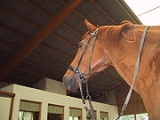
Bitless bridle
Encyclopedia
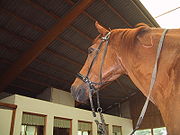
Horse
The horse is one of two extant subspecies of Equus ferus, or the wild horse. It is a single-hooved mammal belonging to the taxonomic family Equidae. The horse has evolved over the past 45 to 55 million years from a small multi-toed creature into the large, single-toed animal of today...
s or other animals that controls the animal without placing a bit
Bit (horse)
A bit is a type of horse tack used in equestrian activities, usually made of metal or a synthetic material, and is placed in the mouth of a horse or other equid and assists a rider in communicating with the animal. It rests on the bars of the mouth in an interdental region where there are no teeth...
in the animal's mouth. Control is maintained by means of some sort of noseband
Noseband
A noseband is the part of a horse's bridle that encircles the nose and jaw of the horse. In English riding, where the noseband is separately attached to its own headstall or crownpiece, held independently of the bit, it is often called a cavesson or caveson noseband...
or cavesson. The term hackamore
Hackamore
A hackamore is a type of animal headgear which does not have a bit. Instead, it has a special type of noseband that works on pressure points on the face, nose, and chin...
is the most historically accurate word for most common forms of bitless headgear. However, some modern bitless designs of horse headgear lack the heavy noseband
Noseband
A noseband is the part of a horse's bridle that encircles the nose and jaw of the horse. In English riding, where the noseband is separately attached to its own headstall or crownpiece, held independently of the bit, it is often called a cavesson or caveson noseband...
of a true hackamore and instead work off of straps that tighten around a horse's head to apply pressure in various ways. These are often specifically patented and marketed as "bitless bridles," usually referencing a particular type of headgear known as the cross-under, though other designs are sometimes also given similar names.
Origins
It is likely that the first domesticated horsesDomestication of the horse
There are a number of hypotheses on many of the key issues regarding the domestication of the horse. Although horses appeared in Paleolithic cave art as early as 30,000 BCE, these were truly wild horses and were probably hunted for meat. How and when horses became domesticated is disputed...
were ridden with some type of noseband
Noseband
A noseband is the part of a horse's bridle that encircles the nose and jaw of the horse. In English riding, where the noseband is separately attached to its own headstall or crownpiece, held independently of the bit, it is often called a cavesson or caveson noseband...
, made of various materials such as sinew, leather, or rope. However, because the materials used to make gear other than metal bits disintegrates quickly, archaeological evidence of the earliest use of bitless designs has been difficult to find. The earliest artistic evidence of use of some form of bitless bridle was found in illustrations of Synian horseman, dated approximately 1400 BC. However, domestication of the horse
Domestication of the horse
There are a number of hypotheses on many of the key issues regarding the domestication of the horse. Although horses appeared in Paleolithic cave art as early as 30,000 BCE, these were truly wild horses and were probably hunted for meat. How and when horses became domesticated is disputed...
occurred between 4500 and 3500 BC, while earliest evidence of the use of bits, located in two sites of the Botai culture, dates to about 3500-3000 BC. Thus there is a very high probability that some sort of headgear was used to control horses prior to the development of the bit.
Ancient Mesopotamia
Mesopotamia
Mesopotamia is a toponym for the area of the Tigris–Euphrates river system, largely corresponding to modern-day Iraq, northeastern Syria, southeastern Turkey and southwestern Iran.Widely considered to be the cradle of civilization, Bronze Age Mesopotamia included Sumer and the...
n forms of bitless headgear were refined into the hakma, a design featuring a heavy braided noseband which dates to the reign of Darius in Ancient Persia, approximately 500 BC. It is the predecessor to the modern bosal
Bosal
A bosal is a type of noseband used on the classic hackamore of the vaquero tradition. It is usually made of braided rawhide and is fitted to the horse in a manner that allows it to rest quietly until the rider uses the reins to give a signal. It acts upon the horse's nose and jaw...
-style hackamore
Hackamore
A hackamore is a type of animal headgear which does not have a bit. Instead, it has a special type of noseband that works on pressure points on the face, nose, and chin...
as well as the French cavesson
Noseband
A noseband is the part of a horse's bridle that encircles the nose and jaw of the horse. In English riding, where the noseband is separately attached to its own headstall or crownpiece, held independently of the bit, it is often called a cavesson or caveson noseband...
, particularly the modern longeing cavesson
Longeing cavesson
A longeing cavesson is a piece of equipment used when longeing a horse. A longeing cavesson consists of a heavy, padded noseband, metal rings to attach the longe line, a throatlatch, and sometimes additional straps such as a jowl strap or a browband for added stability...
.
Some modern styles of "bitless bridle" date to a "bitless safety bridle" patented in 1893, with refinements patented in 1912 and 1915.
Use
Bitless bridles apply pressure to parts of the horse's face and head, such as the nose, jaw and poll, but not to the mouth.Uses of a bitless bridle vary, but may include the training green horses, use when a horse has a mouth injury or is otherwise unable or unwilling to carry a bitted bridle, and by personal preference of horse owners. Bitless designs are most often seen in endurance riding
Endurance riding
Endurance riding is an equestrian sport based on controlled long-distance races. It is one of the international competitions recognized by the FEI. There are endurance rides worldwide....
, trail riding
Trail riding
Trail riding sometimes called horse or pony trekking is riding outdoors on natural trails and roads as opposed to riding in an enclosed area such as a riding arena. The term may encompass those who travel on horses, on mountain bikes, or on motorcycles and other motorized all-terrain vehicles...
, and some types of natural horsemanship
Natural horsemanship
Natural horsemanship is the philosophy of working with horses by appealing to their instincts and herd instincts. It involves communication techniques derived from wild horse observation in order to build a partnership that closely resembles the relationships that exist between horses.- Basic ideas...
, they are sometimes seen in other disciplines.
Use in competition
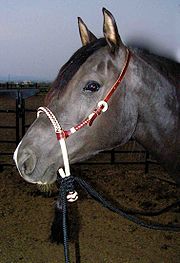
Western riding
Western riding is a style of horseback riding which evolved from the ranching and warfare traditions brought to the Americas by the Spanish Conquistadors, and both equipment and riding style evolved to meet the working needs of the cowboy in the American West...
events, bitless bridles and mechanical hackamores are not otherwise allowed in most types of competitions at horse show
Horse show
A Horse show is a judged exhibition of horses and ponies. Many different horse breeds and equestrian disciplines hold competitions worldwide, from local to the international levels. Most horse shows run from one to three days, sometimes longer for major, all-breed events or national and...
s other than some speed events. In English disciplines, hackamores and other bitless bridles are generally not allowed in dressage
Dressage
Dressage is a competitive equestrian sport, defined by the International Equestrian Federation as "the highest expression of horse training." Competitions are held at all levels from amateur to the World Equestrian Games...
or English pleasure
English Pleasure
English pleasure is generic term for a number of different English riding classes seen at horse shows in the United States, where the horse is ridden in either hunt seat or saddle seat tack....
competition, are considered "unconventional tack" in hunter classes, but sometimes are legal and seen in show jumping
Show jumping
Show jumping, also known as "stadium jumping," "open jumping," or "jumpers," is a member of a family of English riding equestrian events that also includes dressage, eventing, hunters, and equitation. Jumping classes commonly are seen at horse shows throughout the world, including the Olympics...
and in eventing
Eventing
Eventing is an equestrian event comprising dressage, cross-country, and show jumping. This event has its roots in a comprehensive cavalry test requiring mastery of several types of riding...
during the stadium and cross country segments. They are allowed in endurance riding
Endurance riding
Endurance riding is an equestrian sport based on controlled long-distance races. It is one of the international competitions recognized by the FEI. There are endurance rides worldwide....
, competitive trail riding
Competitive trail riding
Competitive Trail Riding is an equestrian sport where riders cover a marked trail for a distance that is usually between 15 and 40 miles per day. Some rides are only one day long, others may run as long as three days....
, rodeo
Rodeo
Rodeo is a competitive sport which arose out of the working practices of cattle herding in Spain, Mexico, and later the United States, Canada, South America and Australia. It was based on the skills required of the working vaqueros and later, cowboys, in what today is the western United States,...
s, and Gymkhana
Gymkhana (equestrian)
Gymkhana is a term used in the United Kingdom, east coast of the United States, and other English-speaking nations to describe an equestrian event consisting of speed pattern racing and timed games for riders on horses...
or "O-Mok-See" events. While advocates of bitless bridles have petitioned the USEF and other governing bodies to allow bitless bridles in sanctioned competition for a number of years, these efforts have not resulted in rule changes.
Styles
There are many different styles of bitless headgear originating from bitted bridleBridle
A bridle is a piece of equipment used to direct a horse. As defined in the Oxford English Dictionary, the "bridle" includes both the headstall that holds a bit that goes in the mouth of a horse, and the reins that are attached to the bit....
and halter
Halter
A halter, headcollar, or, less often, headstall, is headgear that is used to lead or tie up livestock and, occasionally, other animals; it fits behind the ears , and around the muzzle. To handle the animal, usually a lead rope or lead shank is attached...
designs as well as from the ancient Persian hakma.
Bosal style hackamore
The bosalBosal
A bosal is a type of noseband used on the classic hackamore of the vaquero tradition. It is usually made of braided rawhide and is fitted to the horse in a manner that allows it to rest quietly until the rider uses the reins to give a signal. It acts upon the horse's nose and jaw...
- type hackamore, (Spanish: jaquima) is a type of bitless headgear with the most ancient roots. The hackamore and its modern variants use a noseband
Noseband
A noseband is the part of a horse's bridle that encircles the nose and jaw of the horse. In English riding, where the noseband is separately attached to its own headstall or crownpiece, held independently of the bit, it is often called a cavesson or caveson noseband...
of a set diameter, using pressure and release to provide control. It is most closely affiliated with the vaquero
Vaquero
The vaquero is a horse-mounted livestock herder of a tradition that originated on the Iberian peninsula. Today the vaquero is still a part of the doma vaquera, the Spanish tradition of working riding...
tradition of horse training, most commonly seen today in western riding
Western riding
Western riding is a style of horseback riding which evolved from the ranching and warfare traditions brought to the Americas by the Spanish Conquistadors, and both equipment and riding style evolved to meet the working needs of the cowboy in the American West...
for starting young horses. The hackamore, is headgear that controls a horse without a bit, but to call it "bitless bridle," is incorrect other than as a descriptive simile
Simile
A simile is a figure of speech that directly compares two different things, usually by employing the words "like", "as". Even though both similes and metaphors are forms of comparison, similes indirectly compare the two ideas and allow them to remain distinct in spite of their similarities, whereas...
, as the hackamore predates all other modern bitless designs by several hundred years. and the English language term "hackamore" itself dates back at least 150 years.
Sidepull
A variant on the bosal design that is sometimes called a bitless bridle, but more often placed within the hackamore family, is called a sidepull. It has a noseband, usually of rope, rawhide or heavy leather, with reins that attach at the cheekpieces. It offers significant lateral control but limited stopping control.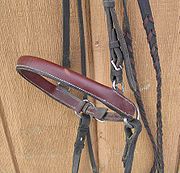
Jumping cavesson
The Jumping Cavesson, or Jumping Hackamore, seen in English ridingEnglish riding
English riding is a term used to describe a form of horse riding that is seen throughout the world. There are many variations in English riding, but all feature a flat English saddle without the deep seat, high cantle or saddle horn seen on a Western saddle nor the knee pads seen on an Australian...
, is a heavy noseband made of a cable covered with leather. It differs slightly from a sidepull in that the reins attach farther back, on either side of the jaw, rather than at the cheeks. It allows greater control of speed, but has less lateral control than a sidepull. A related piece of equipment, called the longeing cavesson
Longeing cavesson
A longeing cavesson is a piece of equipment used when longeing a horse. A longeing cavesson consists of a heavy, padded noseband, metal rings to attach the longe line, a throatlatch, and sometimes additional straps such as a jowl strap or a browband for added stability...
or lungeing cavesson, is not used for riding, but rather for longeing
Longeing
Longeing or lungeing is a technique for training horses, where a horse is asked to work at the end of a long line and respond to commands from a handler on the ground who holds the line. It is also a critical component of the sport of equestrian vaulting...
(US) (lungeing (UK)), long-lining
Driving (horse)
Driving, when applied to horses, ponies, mules, or donkeys, is a broad term for hitching equines to a wagon, carriage, cart, sleigh, or other horse-drawn vehicle by means of a harness and working them in this way...
the horse from the ground, and vaulting
Equestrian vaulting
Equestrian vaulting, or simply Vaulting , is most often described as gymnastics and dance on horseback and, like these disciplines, it can be practised as a non-competitive art/performance or as a competitive sport. Vaulting has been an equestrian act at the circus from its early days. It is open...
. It consists of a heavy noseband with rings at the top and cheeks, held on by a sturdy headstall that will not slip when pressure from the line is applied. Both designs have antecedents in the classic cavesson utilized by European masters such as William Cavendish
William Cavendish
Sir William Cavendish was an English courtier.-Life:He was the younger son of Thomas Cavendish , who was a senior financial official, the "clerk of the pipe", in the Court of Exchequer, and his wife, Alice Smith of Padbrook Hall...
, can be dated to the 17th Century, and probably earlier.
Cross-under family
Evidence of the concept of creating leverage by crossing the reins under a horse's jaw dates back just over 100 years. A bitted bridle with a cross-under design was patented by an individual with the surname McCleod in 1894. The first record of a cross-under bitless design that utilized nose, jaw, cheek and poll pressure, dates to the 1950s, about the same time that patents for the mechanical hackamoreMechanical hackamore
A mechanical hackamore is a piece of horse tack that is a type of bitless headgear for horses where the reins connect to shanks placed between a noseband and a curb chain. Other names include "hackamore bit", "brockamore," "English hackamore," "nose bridle" and "German hackamore." Certain...
began to proliferate. It was developed by an individual with the last name of Grimsley, allegedly designed for a group of rodeo
Rodeo
Rodeo is a competitive sport which arose out of the working practices of cattle herding in Spain, Mexico, and later the United States, Canada, South America and Australia. It was based on the skills required of the working vaqueros and later, cowboys, in what today is the western United States,...
bulldoggers
Steer wrestling
Steer wrestling, also known as bulldogging, is a rodeo event in which a horse-mounted rider chases a steer, drops from the horse to the steer, then wrestles the steer to the ground by twisting its horns. Like all rodeo events, there are concerns from the animal rights community that the competition...
in New Jersey. In 1980, the crossunder principle was part of an individual named Woodruff, who obtained a patent for a halter. The first cross-under bitless bridle that utilized jaw and poll pressure that was patented and filed with the U.S. Patent Office
United States Patent and Trademark Office
The United States Patent and Trademark Office is an agency in the United States Department of Commerce that issues patents to inventors and businesses for their inventions, and trademark registration for product and intellectual property identification.The USPTO is based in Alexandria, Virginia,...
was a 1988 design credited to Edward Allan Buck. The "Dr. Cook bitless bridle" arises from the 1988 design, and the Cook design was patented in the United States in 2001. Another version of the cross-under jaw/poll pressure bitless bridle is called the Spirit Bridle.
Designs applying poll pressure
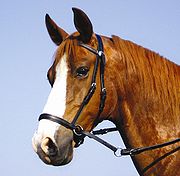
Designs lacking poll pressure
On the Scawbrig (United Kingdom) or Meroth (Germany) bitless bridles, the reins connect to a strap that passes through a ring on one side of a noseband, under the chin, and attaches to the opposite ring. Thus, pressure is applied only to the bridge of the nose and the chin but not to the branches of the lower jaw, cheek or poll.Hybrid designs
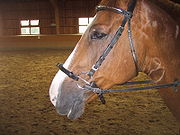
Mechanical hackamore
A mechanical hackamore is a piece of horse tack that is a type of bitless headgear for horses where the reins connect to shanks placed between a noseband and a curb chain. Other names include "hackamore bit", "brockamore," "English hackamore," "nose bridle" and "German hackamore." Certain...
, also known as a hackamore bit, brockamore, and English hackamore, the reins attach to shanks (like bit shanks on a curb bit
Curb bit
A curb bit is a type of bit used for riding horses that uses lever action. It includes the pelham bit and the Weymouth curb along with the traditional "curb bit" used mainly by Western riders....
) that are attached between a noseband and a curb chain
Curb chain
A curb chain, or curb strap, is a piece of horse tack used on any type of curb bit. It is a flat linked chain or strap that runs under the chin groove of the horse, between the bit shank purchase arms. It has a buckle or hook attachment and often has a "fly link" in the middle to apply a lip strap...
. As in a curb bit, the shanks apply pressure with lever
Lever
In physics, a lever is a rigid object that is used with an appropriate fulcrum or pivot point to either multiply the mechanical force that can be applied to another object or resistance force , or multiply the distance and speed at which the opposite end of the rigid object travels.This leverage...
age to the nose, jaw, and poll joint. This is not a true hackamore, nor a modern bitless bridle, but rather is a hybrid between a cavesson
Noseband
A noseband is the part of a horse's bridle that encircles the nose and jaw of the horse. In English riding, where the noseband is separately attached to its own headstall or crownpiece, held independently of the bit, it is often called a cavesson or caveson noseband...
and a bitted bridle. A European design, known as a "Gluecksrad" or "LG bridle," uses metal loops from the headstall to the reins to add leverage, though with less force than the shanks of a mechanical hackamore.
Simple rope bridles
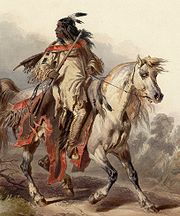
A ghost cord is a rope passed through the mouth and tied in a slip knot
Slip knot
A slip knot is one of two different classes of knot. The most common are knots which attach a line to an object and tighten when tension is applied to the free end of the line...
or half hitch
Half hitch
The half hitch is a simple overhand knot, where the working end of a line is brought over and under the standing part. Insecure on its own, it is a valuable component of a wide variety of useful and reliable hitches, bends, and knots....
under the chin groove. The ends of the rope serve as one or sometimes two reins. One authority describes this bridle as "in competent hands, an instrument of either mental diversion or extreme cruelty", but historical illustrations and early photographs show it in wide use among Native Americans in the United States
Native Americans in the United States
Native Americans in the United States are the indigenous peoples in North America within the boundaries of the present-day continental United States, parts of Alaska, and the island state of Hawaii. They are composed of numerous, distinct tribes, states, and ethnic groups, many of which survive as...
.
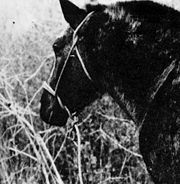
Riding in halters
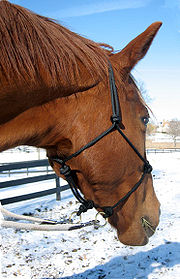
Halter
A halter, headcollar, or, less often, headstall, is headgear that is used to lead or tie up livestock and, occasionally, other animals; it fits behind the ears , and around the muzzle. To handle the animal, usually a lead rope or lead shank is attached...
s, usually made of yacht rope, are designed to be used for riding horses by the addition of various design elements, such as knots on the top of the nose, rings for reins so that it acts like a sidepull, or a heavy bottom knot akin to that of a bosal
Bosal
A bosal is a type of noseband used on the classic hackamore of the vaquero tradition. It is usually made of braided rawhide and is fitted to the horse in a manner that allows it to rest quietly until the rider uses the reins to give a signal. It acts upon the horse's nose and jaw...
. Control is achieved by direct pressure on the nose. There is minimal, if any leverage nor does a halter utilize any type of clamping action.
Some people also ride horses with an ordinary halter
Halter
A halter, headcollar, or, less often, headstall, is headgear that is used to lead or tie up livestock and, occasionally, other animals; it fits behind the ears , and around the muzzle. To handle the animal, usually a lead rope or lead shank is attached...
, though this is generally viewed as unsafe due to the lack of control inherent in the design. Specialized training is required in order for the horse to remain controllable by the rider in a riding halter. They are also not allowed in recognized competitions, save for competitive trail riding
Competitive trail riding
Competitive Trail Riding is an equestrian sport where riders cover a marked trail for a distance that is usually between 15 and 40 miles per day. Some rides are only one day long, others may run as long as three days....
and endurance riding
Endurance riding
Endurance riding is an equestrian sport based on controlled long-distance races. It is one of the international competitions recognized by the FEI. There are endurance rides worldwide....
.
War bridle
A modern war bridle is a thin cord run over the poll and then either through the mouth or under the upper lip, against the gumline of the upper incisors. In some cases, the lower loop goes around the horse's muzzle rather than under the lip. A loop is used so that it tightens on the horse's head when the end of the line is pulled. Sometimes a pulley is used to provide mechanical advantageMechanical advantage
Mechanical advantage is a measure of the force amplification achieved by using a tool, mechanical device or machine system. Ideally, the device preserves the input power and simply trades off forces against movement to obtain a desired amplification in the output force...
. All designs tightens on both the poll and the lip or jaw. The war bridle is not intended for riding; it is used on the ground for management of an animal. The use of a war bridle is considered by some to be a last resort for handling an uncontrollable animal, but others claim its use constitutes animal cruelty.
Controversies
The advantages of bitless over bitted headgear is hotly disputed. Hackamores and other bitless headgear are commonly used to start young horses, particularly if the horse is started at a time when a young horse's permanent teeth are emerging and the animal may therefore have issues with a bit in its mouth. However most traditional schools of horse training transition a young horse into a bit after a year or so. However, some promoters of bitless bridles encourage their use for the life of the horse, and a few go so far as to suggest that a bit may cause physical as well as mental problems in the horse. However, advocates of traditional bridles note that like any piece of horse headgear, a bitless bridle in the wrong hands can also inflict pain. Another significant problem with a bitless bridle is that collectionCollection (horse)
Collection is when a horse carries more weight on his hindlegs than his front legs. The horse draws the body in upon itself so that it becomes like a giant spring whose stored energy can be reclaimed for fighting or running from a predator...
and being "on the bit", such as is required in dressage
Dressage
Dressage is a competitive equestrian sport, defined by the International Equestrian Federation as "the highest expression of horse training." Competitions are held at all levels from amateur to the World Equestrian Games...
, is more difficult, if not impossible. Another problem is that any movement of the horse's head laterally has to be done by unsophisticated "plow reining", or large hand or arm movements.

